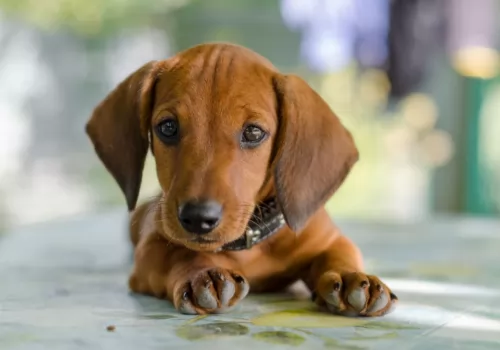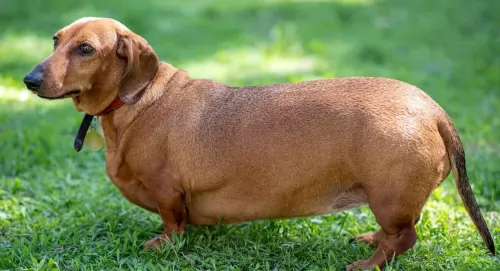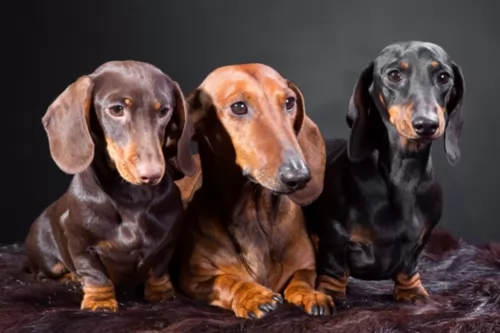 MyDogBreeds
MyDogBreedsMoscow Guard dog is originated from Russia but Dachshund is originated from Germany. Moscow Guard dog may grow 40 cm / 16 inches higher than Dachshund. Moscow Guard dog may weigh 53 kg / 117 pounds more than Dachshund. Moscow Guard dog may live 4 years less than Dachshund. Both Moscow Guard dog and Dachshund has almost same litter size. Moscow Guard dog requires Moderate maintenance. But Dachshund requires Low maintenance
Looking much like the Saint Bernard, the Moscow Guard Dog or Moscow Watchdog is large, descending from quite a few giant breeds such as the Saint Bernard, different Russian Hounds and the Caucasian Ovtcharka.
The dog has a gentle temperament. Known also as a gentle giant, the Moscow Guard Dog was developed in the Soviet Union and is fairly common in its native country.
The first US-born litter of Moscow Guard Dogs was born in 2015. The Moscow Watchdog hasn’t yet been recognized by the AKC.
 The Dachshund originated in Germany. He was used as a hunting dog with his origins starting way back in the 15th century already. The small dog was developed to hunt for animals that buried themselves deep underground such as badgers. The shape of the dog and his courage and bravery allowed him to take on the badger.
The Dachshund originated in Germany. He was used as a hunting dog with his origins starting way back in the 15th century already. The small dog was developed to hunt for animals that buried themselves deep underground such as badgers. The shape of the dog and his courage and bravery allowed him to take on the badger.
There has been a lot of debate as to whether the Dachshund is a hound or terrier, and it was decided that the Dachshund is a hound that became a terrier, and which displays some of the best qualities of both.
It was in 1881 that the Dachshund Club of England was formed and the German Deutscher Teckelklub was formed in 1888. The small dog gained popularity in America and the Dachshund Club of America was founded in 1895.
The Moscow Watchdog is a large mastiff-type dog. He stands at between 64 and 69cm in height ad weighs in the region of 45 – 68kg. He has a thick coat which is medium length, he has floppy ears and a long, plumed tail. The most common colors for the Moscow Watchdog are red and white with a little bit of black and tan around the head.
He is quite a heavy shedder so regular brushing and grooming is recommended.
He takes his role seriously as guardian and protector of his human family.
Large dogs don’t usually live as long as smaller breeds, and with good care your Moscow Watchdog can reach between 9 and 11 years of age. If you want your dog to be a parent, the litter size you can expect is anything from 5 to 10 puppies.
The dogs were used for guarding purposes and they are strong-willed, dominant and independent. They are also gentle dogs but will still require training and socialization to make them obedient and an all-round pleasant dog.
While the Moscow Watchdog is described as a pleasant dog, he isn’t a friendly teddy-bear kind of dog, tending to be fairly aloof. He would do well with an owner who is firm, fair, consistent and strong, as he is strong-willed.
 Known as Badger Dogs, Sausage Dogs or Doxies, the Dachshund is known for his long body, his sharp, pointed face and the short legs with the large front paws.
Known as Badger Dogs, Sausage Dogs or Doxies, the Dachshund is known for his long body, his sharp, pointed face and the short legs with the large front paws.
He stands at about 21-28 cm while the female may be 20-25 cm and weighing 6 to 15kg. He is the smallest of the hound dogs, with the standard size dachshund being developed to scent and chase badgers and other animals.
There are different Dachshund coat varieties – the smooth coat, the long-haired Dachshund and the wire-haired dachshund. They also come in a number of solid colors such as brown, red, tan, chocolate and black.
The dachshund is an energetic,social little dog with a loving personality. He’ll love to lie as close as possible to you on the couch and be with you wherever you are. Training and socialization is important so he doesn’t become too protective so that he wants to go for anyone who comes near.
He can be stubborn but he is also protective of his human family. Dachshunds are known for their tendency to bark but training and socialization can help tremendously to make him obedient and relaxed around humans and pets.
He is small enough to be a great pet in the city or in the country. He loves to spend time indoors- as well as outdoors. He can become a loving companion and gets on well with children and pets in the house. In spite of his small size, he makes a good watchdog.
The Moscow Watchdog is a large dog and beautiful to look at. Even though he is large and strong, he is gentle and calm and makes a splendid pet.
Because of his large size he is better suited to life in the countryside or the suburbs as compared to smaller properties in the city. Their exercise needs will also need to be met such as a walk every day.
Think carefully before you take such a large dog into your home as he will require a lot of good food. Before investing in any dog, make sure that you have the means to provide him with an excellent home where he gets the best care, because he is willing to give you the very best of himself.
 The Dachshund may be small but he is courageous, brave and loyal. He gets on well with children and pets in the home but care needs to be taken because of his long back.These dogs are prone to disk problems so you have to be careful with rough and tumble from children.
The Dachshund may be small but he is courageous, brave and loyal. He gets on well with children and pets in the home but care needs to be taken because of his long back.These dogs are prone to disk problems so you have to be careful with rough and tumble from children.
Dog experts say that the different kinds of Dachshunds produce different personalities and that the longer-coated one is more amicable than the short-coat variety. Whichever variety you choose, they are guaranteed to entertain and delight you and be a loyal, loving companion.
The Moscow Watchdog is a healthy dog breed, and with few inheritable health problems, you’re not likely to spend much at the vet with him.
Of course, any dog needs a good diet, adequate exercise, vaccinations, and parasite treatments to stay in top condition. Some of the common diseases to look out for -
We always have to mention hip dysplasia as it is so common with all dogs. Its an hereditary condition where lack of hip joint stability causes pain inflammation and lameness in the dog. Your dog, even though he is young, can develop hip dysplasia and then it can lead to early arthritis too. Your dog will need to get to the vet.
 The life expectancy of the Dachshund is 12 to 16 years. With good care which includes good nutrition he can reach mature years. However there are always some dog diseases that are worth knowing about so that you can steer your pet away from them.
The life expectancy of the Dachshund is 12 to 16 years. With good care which includes good nutrition he can reach mature years. However there are always some dog diseases that are worth knowing about so that you can steer your pet away from them.
One of these is obesity, and the Dachshund is prone to developing obesity. Never overfeed him and ensure he gets his regular exercise which can be walks and ball games. Check with your vet if you’re unsure about how to feed him. Essentially, the amount of food you give a dog depends on the size of your dog, his age and his activity levels.
Be sure to provide high-quality food and monitor his intake. Your vet is always there to advise on the correct food and amount that can help him remain healthy.
Unfortunately, this dog’s shape – the long back – makes the dog more prone to disc herniation. With some Dachshunds having a gene that creates mineral deposits in the discs in the spine, the risk of herniation is higher.
A large percentage of dachshunds have intervertebral disc disease. Encourage your Dachshund not to jump down off a bed or couch, but rather provide some steps for him to get to out of reach places.
This is a large breed dog so you want to make sure that if you feed him from the many commercially manufactured foods there are, it is the high quality one packed with vitamins and minerals and which cater specifically for large breeds to ensure the right amount of minerals and vitamins for his size.
You don’t want to just go on and on giving him dry kibble every day, so occasionally it will be a good idea to give him some boiled chicken, brown rice or pasta and some cooked vegetables which can be added into his kibble. This is all the variety your dog needs, as dogs like consistency and simplicity because then they don’t suffer with digestive issues.
Never leave him without a constant source of cool, fresh water.
Contrary to what this dog looks like – large and clumsy, he is actually quite agile and will require a good amount of exercise. He may not look particularly active but he will certainly want a daily walk and he will also require running off the leash in the park or some ball and rope games in the garden.
he Moscow Watchdog has a thick, medium length coat. He doesn’t require professional grooming, but a good brush through once a week will help to condition the coat. Also, the breed is a moderate shedder so removing loose hair keeps the coat shiny and healthy.
 The Dachshund is a medium shedder and if you choose the short haired dog, you’re going to have a low maintenance pet.
The Dachshund is a medium shedder and if you choose the short haired dog, you’re going to have a low maintenance pet.
The long haired Dachshund will require more regular brushing but the short-haired Dachshund is a low maintenance dog that will require a brush once a week.
While brushing him, you can be checking his ears and nails at the same time. All dogs with floppy ears need to have them checked for ear infections. Also, maintain good oral hygiene with your Dachshund by brushing his teeth 2 or 3 times a week.